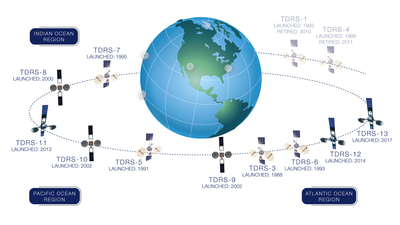
Back تتبع وترحيل بيانات الأقمار الاصطناعية Arabic Tracking and Data Relay Satellite Czech Tracking and Data Relay Satellite Danish Tracking and Data Relay Satellite German Spurada kaj Datum-Relajsa Sputnikaro Esperanto Tracking and Data Relay Satellite Spanish ماهواره ردیابی و بازپخش دادهها Persian Tracking and Data Relay Satellite French Tracking and Data Relay Satellite Galician TDRS HE
This article needs to be updated. (June 2024) |

A tracking and data relay satellite (TDRS) is a type of communications satellite that forms part of the Tracking and Data Relay Satellite System (TDRSS) used by NASA and other United States government agencies for communications to and from independent "User Platforms" such as satellites, balloons, aircraft, the International Space Station, and remote bases like the Amundsen-Scott South Pole Station. This system was designed to replace an existing worldwide network of ground stations that had supported all of NASA's crewed flight missions and uncrewed satellites in low-Earth orbits. The primary system design goal was to increase the amount of time that these spacecraft were in communication with the ground and improve the amount of data that could be transferred. These TDRSS satellites are all designed and built to be launched to and function in geosynchronous orbit, 35,786 km (22,236 mi) above the surface of the Earth.
The first seven TDRSS satellites were built by the TRW corporation. The three later versions have been manufactured by the Boeing corporation's Satellite Systems division. Thirteen satellites have been launched; however, one was destroyed in the Challenger disaster. TDRS-1 was decommissioned in October 2009.[1] TDRS-4 was decommissioned in December 2011. Ten TDRSS satellites are currently in service.[2] All of the TDRSS satellites have been managed by NASA's Goddard Space Flight Center.[3] The contract for TDRS versions L & K was awarded to Boeing on December 20, 2007.[4] On November 30, 2011, NASA announced the decision to order an additional third-generation TDRS satellite, TDRS M.[5]
In 2022 NASA announced it would begin to phase out the TDRS system and hand off satellite relay services to commercial providers.[6] In 2024 it announced that while TDRS satellites would probably continue to operate for a decade or more, all new orbital missions would communicate through privately-operated satellite networks.[7]
- ^ "Breaking News | NASA retires 'queen' of tracking satellite fleet". Spaceflight Now. Retrieved February 5, 2014.
- ^ "Tracking and Data Relay Satellite (TDRS) | NASA". Spacecomm.nasa.gov. October 22, 2019. Retrieved October 22, 2019.
- ^ "NASA – Top Story – TDRS 20th Anniversary – April 03, 2003". Nasa.gov. Retrieved February 5, 2014.
- ^ "Boeing to build NASA tracking, data relay satellites". Reuters. December 20, 2007. Retrieved February 5, 2014.
- ^ Cite error: The named reference
NASAwas invoked but never defined (see the help page). - ^ "Companies Vie to Build NASA's Next Communications Network - IEEE Spectrum". spectrum.ieee.org. Retrieved October 17, 2024.
- ^ "NASA to Embrace Commercial Sector, Fly Out Legacy Relay Fleet - NASA". October 16, 2024. Retrieved October 17, 2024.